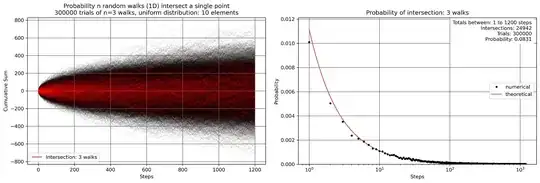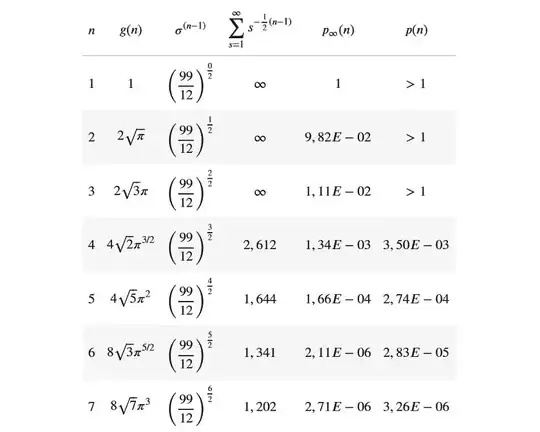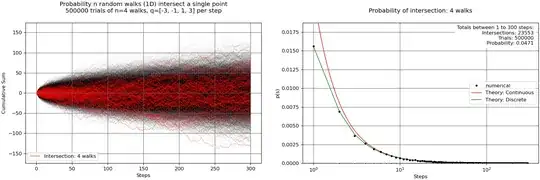I am struggling finding a relation to determine the probability $n$ random walks (1D) intersect in a single point at step $s$. In the method below my attempts. My method is somewhat intuitive based. I am looking for more rigorous proof.
note: This question arises from someone who claims that a matching cumulative digit sum of: $\pi$, $e$ and $\varphi$ (golden ratio) is unique and "cosmological" [1]. I tend to disprove it. This digit sum can be seen as a random walk if the constants are normal (every digit occurs with same frequency).
Method:
For every step $s$ on the random walk we can determine the probability density function if we know the standard deviation on every step $s$.
The standard deviation of a single step can be calculated it's a discrete uniform distribution "equally likely outcomes", where $q$ is the number of outcomes e.g. the number of digits $[0,1,2,3,4,5,6,7,8,9]$, $q=10$:
$$\sigma=\sqrt{\frac{q^{2}-1}{12}} $$
All the (1D) random walks start in the origin for this example. The standard deviation will grow with every step $s$, the variance is proportional to the number of steps [2].
$$Var(s)=s \cdot \sigma^{2}$$
$$\sigma(s)=\sqrt{s} \cdot \sigma$$
While the bins grow rapid I assume a normal approximation of the Binomial distribution.
$$f(x)=\int_{-\infty}^{\infty} {\frac {1}{\sigma {\sqrt {2\pi }}}}e^{-{\frac {1}{2}}\left({\frac {x}{\sigma }}\right)^{2}}dx $$
The probability that $n$ random walks intercept in a single point is (not sure):
$$p(s)=\int_{-\infty}^{\infty} \left[ {\frac {1}{\sigma {\sqrt {2\pi }}}}e^{-{\frac {1}{2}}\left({\frac {x}{\sigma }}\right)^{2}} \right]^n dx $$
With help of Wolfram Alpha [3] the solution is found for $n=3$ meaning the probability of $3$ point intersecting random walks.
$$p(s)=\frac{1}{2 \sqrt{3} \ \pi \ \sigma^{2}} \cdot \frac{1}{s}$$
The total probability $p(n)$ is proportional to the reciprocal sum of $s$. So the total probability is proportional to the harmonic series:
$$p(n)=\frac{1}{2 \sqrt{3} \ \pi \ \sigma^{2}} \cdot \sum_{s=1}^{\infty}\frac{1}{s}$$
This series diverges, meaning there are infinate point intersections of $n=3$ random walks. So a matching cumulative digit sum of $\pi$, $e$ and $\varphi$ is not unique, probability $\sim 8 \%$ for the first 1200 digits (see graph).
Question
Does anyone know the general formula for the probability $p(n)$ that $n$ random walks (1D) intersect a single point?
import numpy as np
#Elements of digits [0,1,2,3,4,5,6,7,8,9] rescaled to fit random walk
array=[-9,-7,-5,-3,-1,1,3,5,7,9]
#steps, in single random walk, x walks to intercept, number of trial to find intercept
steps=2500
xwalks=3
trials=1500
#Set output array to zero
count=np.full([steps],0)
for n in range(trials):
#Identify initial array, set total array to zero
w0=np.random.choice(array,steps)
w0=np.cumsum(w0)
total=np.full([steps],0)
#Select x random walk check for intercept
for m in range(xwalks-1):
#Next current random walk
w=np.random.choice(array,steps)
w=np.cumsum(w)
#Compare previous and current random walk
eq=np.equal(w0,w)
eq=eq.astype(int)
#Count intercepts
total=total+eq
#Set current walk to previous
w0=w
#Sum all interceptions for all trials
count=count+np.where(total==(xwalks-1),1,0)
#Print output
print(count)
print(np.sum(count))
print(np.sum(count)/trials)



